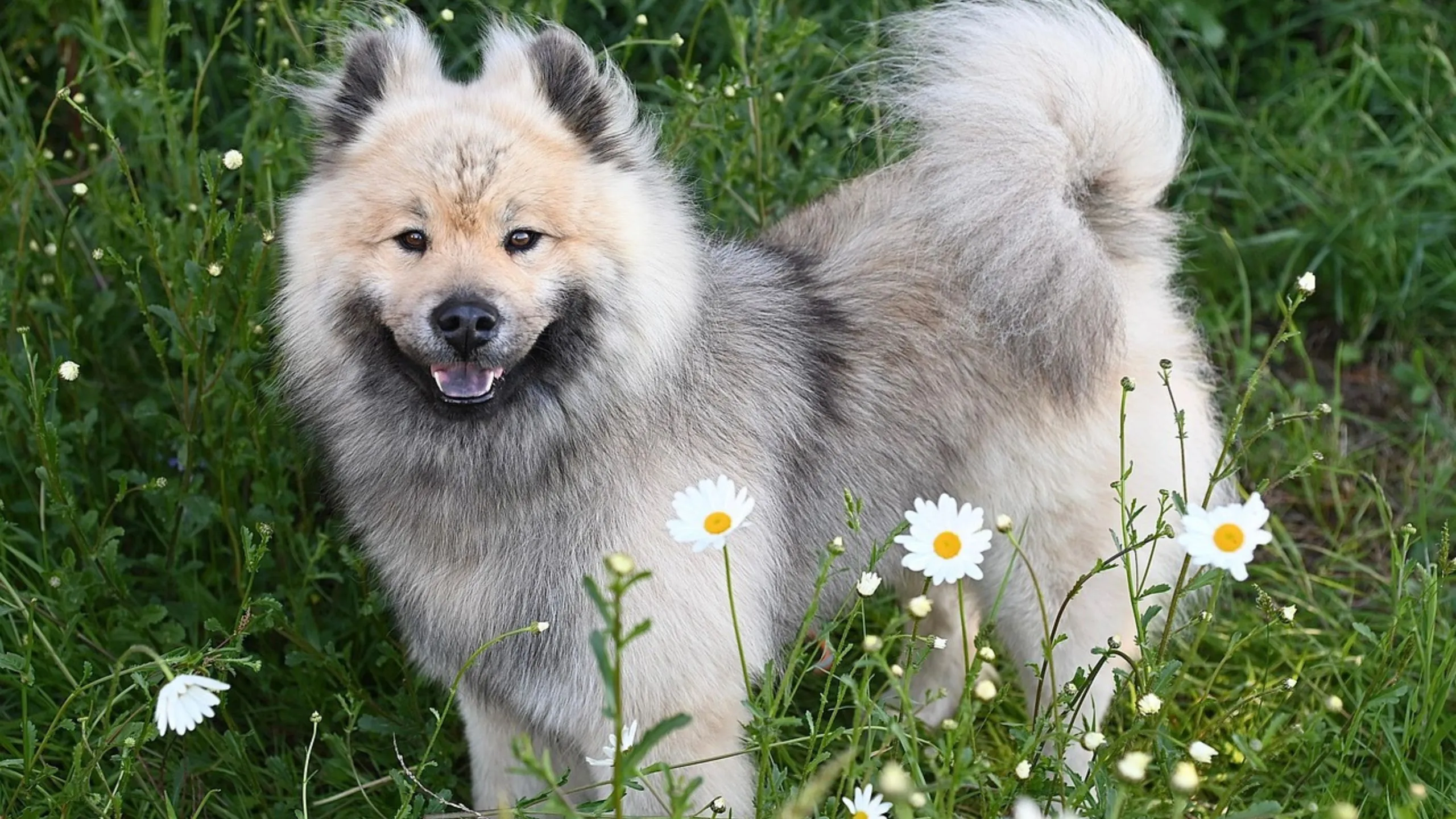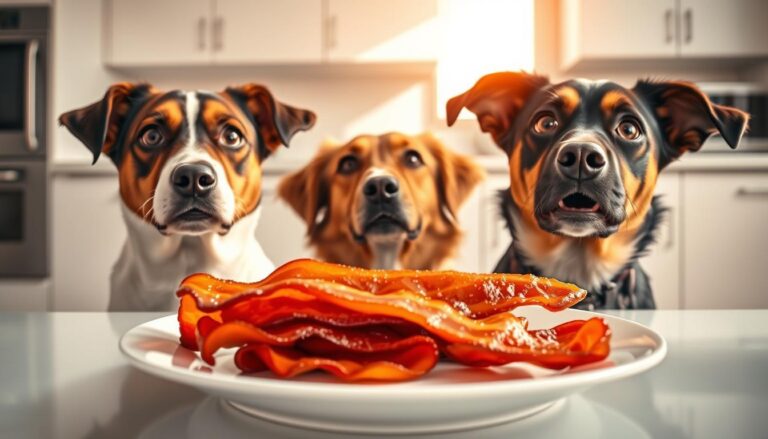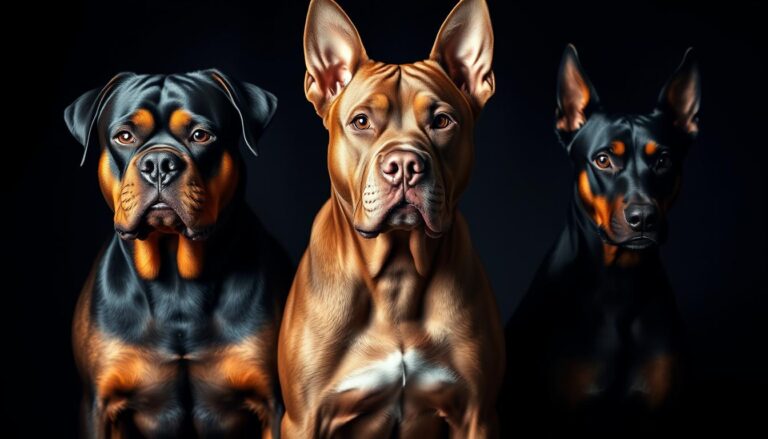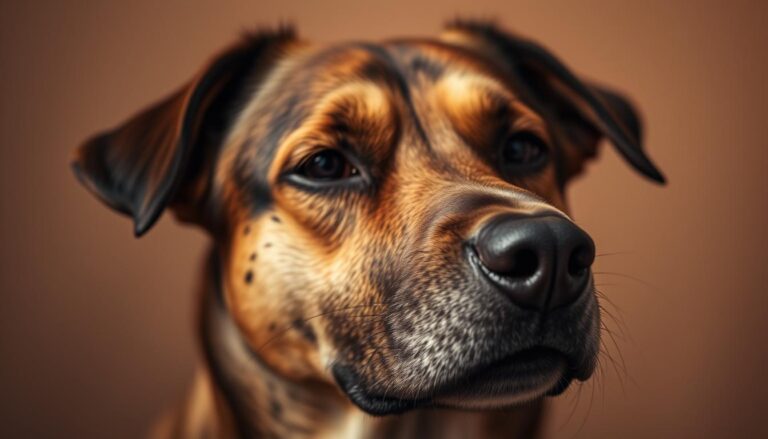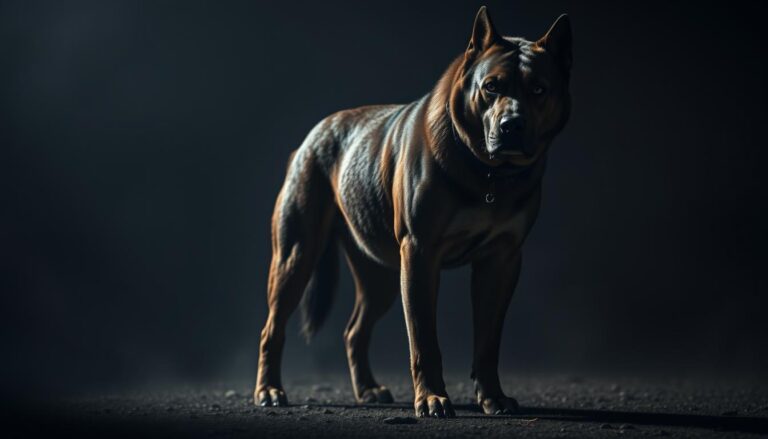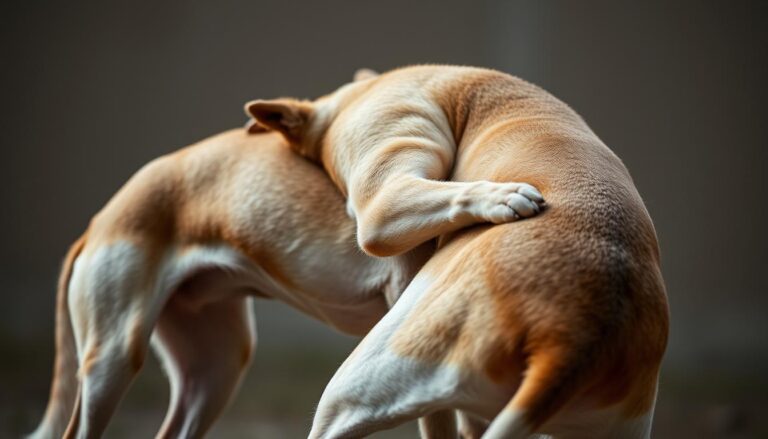Top 10 Big Fluffy Dog Breeds That Love Cold Weather
Table of Contents
Winter mornings are magical with a big, warm dog by your side. Growing up in Colorado’s mountains, I know how great big dogs are in cold weather.
Big fluffy dogs are more than cute friends. They’re like built-in heaters with special skills. These dogs love cold weather and are perfect for snow fans.
Ever wanted a big, cuddly dog to make winter fun? This guide shows you ten amazing breeds. Each one is special and loves cold weather.
Meet the Siberian Husky and Alpine dogs, among others. They’re built for winter, with thick coats and strong bodies. They’re not just pets; they’re winter heroes.
Ready to find the best winter dog friends? They’ll make your winter warm and wonderful.
Understanding Cold-Weather Dogs and Their Unique Characteristics
Giant hairy pups have evolved to thrive in extreme cold. They have special physical traits that help them survive and work in harsh winter conditions.
Cold-weather dog breeds are nature’s ultimate survival specialists. Their genetic adaptations go beyond just keeping warm. They create living systems that function in freezing temperatures.
Physical Adaptations for Cold Climates
Cold-climate dogs have special traits to protect them from harsh weather. These traits include:
- Thick double-layer coats with dense undercoats
- Large, furry paw pads for snow traction
- Broad chest and muscular build for heat retention
- Compact ears to minimize heat loss
Natural Insulation Properties
The insulation of these massive woolly canines is remarkable. Their coat structure offers multiple layers of protection against extreme cold:
| Coat Layer | Function |
|---|---|
| Undercoat | Traps warm air close to skin |
| Outer Guard Hairs | Repels moisture and wind |
| Skin Oils | Provides additional water resistance |
Historical Working Background
Many giant hairy pups come from extremely cold regions. They were not just pets but crucial working animals. They helped humans survive in tough environments.
“Survival in cold regions depended on dogs’ ability to work alongside humans, pulling sleds, guarding livestock, and providing warmth.” – Canine Historians Research Group
Understanding these unique traits shows how these breeds adapted to the world’s toughest environments.
Big Fluffy Dog Breeds: A Complete Overview
Dog lovers have many gigantic shaggy pooches to choose from. These colossal fluffy companions come in various sizes. Each breed has unique traits that make them special.
Big fluffy dog breeds have common characteristics. Their size and luxurious coats are just the start. They fall into several categories:
- Working breeds with historical roles in cold climates
- Guardian breeds with protective instincts
- Companion dogs known for their gentle temperaments
When looking at gigantic shaggy pooches, consider a few things. Grooming needs are high, with regular brushing and professional care. Their coats vary, needing different care.
Energy levels and exercise needs differ among breeds. Some need a lot of activity, while others are more relaxed. It’s important to match the dog’s needs with your lifestyle.
Key things to think about include:
- Grooming commitment
- Exercise requirements
- Living space availability
- Climate compatibility
Choosing a big fluffy dog breed is an exciting journey. These magnificent animals offer companionship, protection, and endless love. They are perfect for those ready to meet their unique needs.
Siberian Husky: The Ultimate Snow Dog
The Siberian Husky is a standout among huge fuzzy pets, perfect for winter. They are known for their cold-weather skills and beautiful looks.
Coming from the Siberian Arctic, these dogs are built for winter. Their special traits and toughness make them unique among dogs.
Physical Characteristics
Siberian Huskies have amazing features for cold weather:
- Thick double-layer coat with dense undercoat
- Almond-shaped eyes that protect against snow glare
- Erect triangular ears for maximum heat preservation
- Compact body structure minimizing heat loss
Temperature Tolerance
| Temperature Range | Husky Performance |
|---|---|
| -20°F to 0°F | Comfortable and active |
| 0°F to 32°F | Optimal working conditions |
| Above 32°F | Requires cooling and shade |
Exercise Requirements
These huge fuzzy pets need lots of exercise. Siberian Huskies require:
- Minimum 1-2 hours of intense exercise daily
- Stimulating mental challenges
- Space to run and explore
- Regular long walks or sledding activities
Potential owners should understand that Siberian Huskies are not just pets, but athletic companions requiring dedicated physical engagement.
Saint Bernard: The Gentle Alpine Giant
When you think of huge soft-coated dogs, the Saint Bernard is the first one that comes to mind. These giant dogs came from the Swiss Alps. They became famous for rescuing travelers stuck in the mountains.
The Saint Bernard’s story starts with monks in the Alps. They bred these dogs to help travelers on dangerous paths. Thanks to their skills, they became true heroes.
- Weight range: 120-180 pounds
- Height: 26-30 inches at the shoulder
- Coat type: Dense, water-resistant double coat
- Typical colors: White with red or brown markings
These gentle giants have a special temperament. They are huge but calm and patient. This makes them great family pets.
| Characteristic | Details |
|---|---|
| Temperament | Gentle, Patient, Intelligent |
| Exercise Needs | Moderate – Daily walks and play sessions |
| Grooming Requirements | High – Regular brushing to manage heavy shedding |
Your Saint Bernard needs a lot of grooming. Brushing them regularly helps with their heavy shedding. Despite their size, they are gentle and loving.
“A Saint Bernard doesn’t just guard your home – they become an integral part of your family.” – Alpine Dog Experts
Alaskan Malamute: Built for Arctic Conditions
The Alaskan Malamute is a standout among big fluffy dog breeds. These dogs were made to handle the harshest cold. Their strong build and thick coat make them perfect for winter.
These dogs come from the Mahlemut tribe in northwestern Alaska. They were key for survival, helping with transport, hunting, and more.
Working Heritage
Alaskan Malamutes were bred to be strong freight dogs. They have a long history of endurance. Their main jobs were:
- Pulling heavy sleds across frozen landscapes
- Hunting large game in tough terrains
- Keeping their humans warm and safe
Coat Care and Maintenance
Keeping their coat in top shape is a big job. They need regular grooming to avoid mats and stay healthy.
| Grooming Aspect | Frequency | Tools Needed |
|---|---|---|
| Brushing | 2-3 times weekly | Undercoat rake, slicker brush |
| Bathing | Every 6-8 weeks | Dog-specific shampoo |
| Shedding Management | Seasonal (twice yearly) | Professional deshedding tools |
Exercise Needs
Alaskan Malamutes are very active. Daily exercise is crucial for their health. They love:
- Long walks
- Hiking
- Pulling activities
- Interactive play sessions
These dogs have a rich history and are very loyal. They are great companions for those ready to meet their needs.
Bernese Mountain Dog: The Swiss Working Companion
The Bernese Mountain Dog is a standout among giant hairy pups. It has a stunning tri-color coat and a rich heritage. These dogs come from the Swiss Alps, where they became strong and enduring working dogs.
Bred for tasks like drafting and herding, they have a long history. They helped farmers in the mountains. Their thick coat and strong build make them great for cold weather.
- Origin: Canton of Bern, Switzerland
- Primary working functions: Drafting, herding, farm work
- Coat: Dense, long double-coat
- Colors: Black, white, and rust-brown
Understanding these gentle giants is key. Bernese Mountain Dogs are known for their exceptional temperament. They are deeply loyal to their families.
| Characteristic | Details |
|---|---|
| Weight | 70-115 pounds |
| Height | 23-27.5 inches |
| Lifespan | 7-10 years |
| Exercise Needs | Moderate |
These dogs need regular grooming because of their thick coat. Brush them often to manage shedding and keep them looking great. Despite their size, they fit well into family life and are great with kids.
If you’re looking for a loyal, powerful companion for cooler climates, the Bernese Mountain Dog is a great choice.
Newfoundland: The Water-Loving Giant
Meet the Newfoundlands, the gigantic shaggy pooches that have won the hearts of dog lovers everywhere. These colossal fluffy companions are not just impressive-looking. They are also intelligent, versatile, and incredibly loving family members with a special bond to water.
Cold Water Adaptations
Newfoundlands are nature’s ultimate water rescue dogs. Their amazing physical traits make them exceptional swimmers:
- Thick, water-resistant double coat provides exceptional insulation
- Webbed feet enable powerful swimming movements
- Muscular build allows them to navigate challenging water conditions
Family Compatibility
Known as the gentle giants of the dog world, Newfoundlands are perfect for families. Their patient and protective nature makes them great companions for both kids and adults.
| Personality Trait | Description |
|---|---|
| Temperament | Calm, Sweet-natured, Patient |
| Child Interaction | Extremely Gentle and Protective |
| Social Behavior | Friendly with Family and Strangers |
Grooming Requirements
Maintaining these gigantic shaggy pooches requires dedicated grooming. Their luxurious coat needs regular care to keep them looking and feeling their best.
- Brush 3-4 times weekly to prevent matting
- Periodic professional grooming recommended
- Regular ear and dental checks
- Manage occasional drooling with frequent cleaning
Newfoundlands are the ultimate example of colossal fluffy companions. They combine strength, intelligence, and unmatched water skills with a heart of pure gold.
Caring for Cold-Weather Dog Breeds in Various Climates
Huge fuzzy pets like cold-weather dog breeds need special care in warmer places. They might find it hard to handle the heat. But, with the right care, they can do well in different climates.
It’s important to help these thick-coated dogs adjust to different temperatures. The right care can prevent health problems from temperature changes. Here are some tips to keep your cold-weather dogs comfy:
- Provide constant access to cool, shaded areas
- Use cooling mats or elevated beds
- Maintain regular grooming routines
- Adjust exercise schedules during hot weather
Grooming is key to keeping your huge fuzzy pets comfortable. Regular brushing helps get rid of extra undercoat and stops matting. Matting can trap heat and make them uncomfortable.
| Climate Type | Special Care Recommendations |
|---|---|
| Hot/Humid | Early morning/late evening walks, indoor cooling |
| Moderate | Regular exercise, consistent grooming |
| Mild | Standard care, monitor hydration |
Warning signs of heat stress in enormous furry friends include excessive panting, lethargy, and difficulty breathing. Always consult your veterinarian if you notice these symptoms.
“Understanding your dog’s unique needs is the key to keeping them healthy in any environment.” – Veterinary Nutrition Expert
By following these tips, you can make sure your cold-weather dog stays comfy and healthy, no matter the climate.
Conclusion
Your journey into the world of mammoth soft-coated dogs is fascinating. These dogs are more than pets; they carry rich traditions and amazing adaptations. They make great companions for active families.
Remember, these breeds need more than just your love. They need proper food, exercise, and grooming to stay healthy and happy. Breeds like the Siberian Husky, Saint Bernard, Alaskan Malamute, and Newfoundland each have unique qualities.
Knowing what these dogs need is key to a great partnership. They thrive in cold weather but can adjust to different homes with the right care. Learning about their history, needs, and personality will strengthen your bond.
Choosing the right cold-weather breed takes research and realistic expectations. Each dog is a lifelong friend, promising years of love and adventure. With the right knowledge and passion, you’ll welcome a special dog into your life.
FAQ
What makes a dog breed suitable for cold weather?
How much grooming do big fluffy dog breeds require?
Can these cold-weather dog breeds live in warm climates?
How much exercise do big fluffy dog breeds need?
Are these breeds good with children?
What are the typical health concerns for big fluffy dog breeds?
How expensive are these dog breeds?
What makes a dog breed suitable for cold weather?
How much grooming do big fluffy dog breeds require?
Can these cold-weather dog breeds live in warm climates?
How much exercise do big fluffy dog breeds need?
Are these breeds good with children?
What are the typical health concerns for big fluffy dog breeds?
How expensive are these dog breeds?
FAQ
What makes a dog breed suitable for cold weather?
Cold-weather dog breeds have thick double coats and sturdy builds. These features help them stay warm in freezing temperatures. They also have dense fur and can handle very low temperatures.
How much grooming do big fluffy dog breeds require?
Big, fluffy dog breeds need a lot of grooming. Brush them several times a week, or every day during shedding seasons. Their coats can mat, so regular brushing is key to prevent skin problems.
Professional grooming every 6-8 weeks is often needed for breeds like Newfoundlands and Saint Bernards.
Can these cold-weather dog breeds live in warm climates?
Yes, these breeds can live in warm climates with the right care. Provide air conditioning and avoid midday heat. Make sure they have plenty of water and trim their coats carefully.
However, they may struggle with extreme heat. So, take extra precautions to prevent overheating.
How much exercise do big fluffy dog breeds need?
Exercise needs vary by breed. Siberian Huskies and Alaskan Malamutes need 1-2 hours of exercise daily. Bernese Mountain Dogs need 30-60 minutes of moderate exercise.
Consider the dog’s age, health, and energy level when planning exercise.
Are these breeds good with children?
Many big fluffy dog breeds are great with families. Saint Bernards and Newfoundlands are known for their gentle nature. They usually get along well with children.
However, their size means you should always supervise to prevent accidents, especially with younger kids.
What are the typical health concerns for big fluffy dog breeds?
Large fluffy breeds can face health issues like hip dysplasia and bloat. Saint Bernards may have heart problems, while Newfoundlands can have joint issues.
Regular vet visits, a healthy weight, and proper nutrition are key to managing these risks.
How expensive are these dog breeds?
Prices for big fluffy dog breeds vary. Purebred puppies can cost between
FAQ
What makes a dog breed suitable for cold weather?
Cold-weather dog breeds have thick double coats and sturdy builds. These features help them stay warm in freezing temperatures. They also have dense fur and can handle very low temperatures.
How much grooming do big fluffy dog breeds require?
Big, fluffy dog breeds need a lot of grooming. Brush them several times a week, or every day during shedding seasons. Their coats can mat, so regular brushing is key to prevent skin problems.
Professional grooming every 6-8 weeks is often needed for breeds like Newfoundlands and Saint Bernards.
Can these cold-weather dog breeds live in warm climates?
Yes, these breeds can live in warm climates with the right care. Provide air conditioning and avoid midday heat. Make sure they have plenty of water and trim their coats carefully.
However, they may struggle with extreme heat. So, take extra precautions to prevent overheating.
How much exercise do big fluffy dog breeds need?
Exercise needs vary by breed. Siberian Huskies and Alaskan Malamutes need 1-2 hours of exercise daily. Bernese Mountain Dogs need 30-60 minutes of moderate exercise.
Consider the dog’s age, health, and energy level when planning exercise.
Are these breeds good with children?
Many big fluffy dog breeds are great with families. Saint Bernards and Newfoundlands are known for their gentle nature. They usually get along well with children.
However, their size means you should always supervise to prevent accidents, especially with younger kids.
What are the typical health concerns for big fluffy dog breeds?
Large fluffy breeds can face health issues like hip dysplasia and bloat. Saint Bernards may have heart problems, while Newfoundlands can have joint issues.
Regular vet visits, a healthy weight, and proper nutrition are key to managing these risks.
How expensive are these dog breeds?
Prices for big fluffy dog breeds vary. Purebred puppies can cost between $1,500 and $5,000. This depends on the breed, lineage, and location.
Additional costs include food, grooming, vet care, and health treatments specific to large breeds.
Do these dogs shed a lot?
Yes, most big fluffy dog breeds shed a lot. Breeds like Alaskan Malamutes and Siberian Huskies shed heavily, especially during seasonal changes.
You’ll need a good vacuum and regular grooming tools to manage their shedding.
,500 and ,000. This depends on the breed, lineage, and location.
Additional costs include food, grooming, vet care, and health treatments specific to large breeds.
Do these dogs shed a lot?
Yes, most big fluffy dog breeds shed a lot. Breeds like Alaskan Malamutes and Siberian Huskies shed heavily, especially during seasonal changes.
You’ll need a good vacuum and regular grooming tools to manage their shedding.

